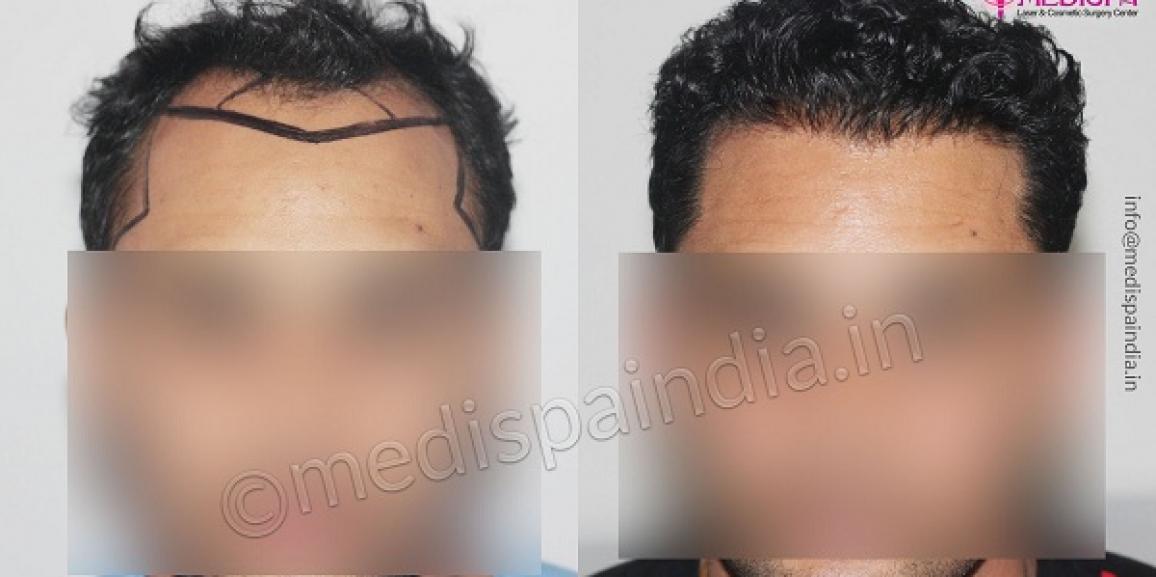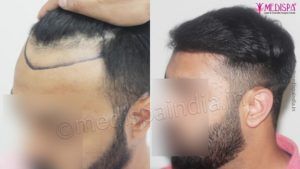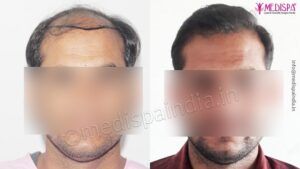
What is a hair transplant?
Hair transplantation is a rapidly evolving field where hair restoration surgeons are trying to find newer methods to improve the graft yield and improve the overall final aesthetic hair transplant results. Traditionally, hair transplantation utilizes harvesting of follicles from safe donor area of the scalp and transplantation of these follicles in to the balding areas on the scalp to yield best hair transplant results.
Why body hairs are required for hair transplant?
There is a limited supply of follicles to be harvested from the safe donor area zone; approximately up to a maximum of 6000 hair follicular units in best of donor area density. This is inadequate to provide appropriate coverage, especially in advanced grades VI and VII of Norwood scale in androgenetic alopecia. In such cases, hair follicles from other parts of body inclusive of beard, chest, arms, and legs in hirsute individuals can be utilized as source of additional donor supply to provide excellent hair transplant results.
Which hair transplant technique is followed for harvesting hair grafts from areas other than scalp?
While conventional follicular unit transplant (FUT) is a suitable procedure for harvesting from the scalp, it may be problematic and leave cosmetically unacceptable scaring if used for harvesting body hairs. Follicular unit extraction (FUE) on the other hand is much more suitable for harvesting body hairs, which instead of removing a strip of hair bearing skin, uses punches to individually extract the follicular units and provide suitable hair transplant results. The circular punch wounds heal with secondary intention in a few days. In FUE, individual follicular units from the donor site (body or scalp) are harvested one graft at a time using circular punches. FUE involves use of sharp or dull punches of various diameters ranging from 0.7 to 1.3 mm. It is unlike FUT because a linear donor strip is not excised, and postoperative wound healing is quicker and less traumatic for patients; thus, provides good hair transplant results.
Characteristics of body hairs
- Most of the hair on human body is vellus hair, which cannot be used for hair restoration. The body hair grows shorter and thinner as compared to scalp hair. It is only the beard hair that grows thicker in comparison to the scalp hair. Thus, body hair transplant results are not good and natural looking as hair transplant from scalp hairs.
- Body hair is often curled and post-transplant almost always curls as it grows beyond a certain length. However, with grooming and straightening the curliness of body hair can be reduced for better match with the native scalp hair.
- Body hair lie more superficially in the dermis than the scalp hair, which are anchored at the level of subcutaneous tissue. The resultant hair transplant result is not satisfactorily and looks unnatural.
- Body hairs emerge from the skin surface at a more acute angle in comparison to the scalp hair which can be easily noticed.
- Generally, body hair grows singly, at times follicular units having two or three follicles are found and harvested from beard and chest areas.
Indications for harvesting body or non-scalp hair for hair transplant
- Hirsute individuals with adequate terminal hairs over beard, chest, legs, arms, and other body parts
- Advanced grades of androgenetic alopecia, e.g., Norwood grades 6 or 7, where donor scalp hair is inadequate to provide complete or adequate coverage
- Exhaustion of available scalp donor hair due to previous restoration surgeries, with inadequate coverage of existing bald areas requiring more follicular units for aesthetic restoration result
- Combining with scalp donor hair to improve recipient area density to improve the final cosmetic result
- To camouflage or seal a low density thinned out post-FUE harvest safe donor area zone in the scalp, to camouflage linear FUT scar in donor area
- Fine caliber body hair can be utilized for softening of hairline and in temporal area restoration
- Lack of adequate donor scalp hair in cases of cicatricial alopecia where scarring process is so extensive that there is lack of donor hair from scalp to provide adequate coverage in scarring patches
Complications with body hair transplant
- Hypopigmentation at the extraction site of beard hair may occur especially in darker skin patients; harvesting from under the chin or submandibular region makes this effect less visible.
- Keloid formation can occur especially around the sternal area. By avoiding harvesting of follicles from sternal area and ruling out keloidal tendencies in history helps in avoiding keloid formation. Often patients who have keloidal tendencies do not present with keloids. Alternately, if planning for chest hair extraction, one can perform few test punches and wait for few weeks to see if keloid develops or not.
- Other complications that are likely to occur are folliculitis and ingrowing hair due to buried grafts. Awareness of local anatomy especially facial anatomy to avoid motor nerve damage and loss is essential during harvesting in beard areas.
Benefit of body hair transplant
Body hair transplant can serve as viable option for providing good hair transplant results in select hirsute individuals in advanced cases of androgenetic alopecia who have a limited supply of scalp donor hair.
Demerits of hair transplant
- Harvesting of body hair grafts is slower due to their placement and rapidly changing orientation in different body areas as compared to scalp hair and higher transection rates are observed while harvesting for the same reasons.
- Body hair transplant requires higher degree of skill to achieve satisfactory results.
- Lower density of body hair follicles, slower harvesting times, operators’ fatigue due to demanding nature of the procedure, anesthesia requirements, and patient discomfort limits the total number of body hair grafts that can be harvested per session.
- Compared to scalp hair, body hair with the exception of beard is thinner and mostly occurring as singular hair follicles in individual follicular units; consequently more body hair follicular units are required to give a similar density, volume, and coverage in the balding scalp versus scalp hairs.
- Increased surgeon fatigue due to longer duration and higher skill requirement may also contribute to poor graft yield.
- In body hair transplant, final yields are lower as compared to scalp hairs.
Well counseled patients generally are satisfied with the outcome of this surgical procedure. Umar S in an extensive study of more than 122 patients, found all patients completing the study (63.1%) reported a good assessment of healing, hair growth and high overall satisfaction with the surgical outcome.[8] The highest scores were given by the patients who in addition to body hairs also utilized head and nape of neck and periauricular hair as donor sources. When beard hair was utilized the patients reported similar degree of satisfaction with result and hair growth when compared to patients in whom scalp hair and hairs from nape and periauricualr area were combined. Whereas in the patients where body hairs from areas other than scalp and beard were used (trunk, limbs, axilla, and pubic hair) reported marginally lower scores in terms of donor area healing and growth rates.[29] There is a requirement of more controlled studies to understand the long-term efficacy and side effects of body hair transplant; with respect to yields, effects of recipient influence on anagen duration, growth rates, and characteristics like length, density, and long-term survival of these transplanted body hairs. There is a need for a scoring system for patient selection based on total graft requirements, availability of quality as well as quantity of donor hair from different body sources to predict a successful outcome. Robert True has presented a scoring system termed Torso Donor Index (TDI) [Table 2].[30] This evaluates five key patient characteristics of chest hairs: Density, which may be more than 40FU/cm2, similarity between scalp and torso hair, proportion of 2–3 hair follicular units, size of the hair bearing area, and length of the torso hair. Where the Torso Donor Index is less than 4, the patient is deemed unsuitable for a body hair transplant, whereas patients with a TDI score of 5–7 may be suitable under certain circumstances. Patients with a score of 8 or more have more body hair than scalp hair suitable as donor material and are therefore suitable candidates for a body hair transplant.
Tips to be followed while doing body hair transplant to provide natural hair transplant result
Initially, while harvesting from the body, each scoring incision must be followed by extraction for the first few grafts; this enables the operating physician to determine the body hair characteristics like depth, angle, and intradermal course (curl) of the follicle and make appropriate adjustments to the scoring method to minimize trauma and transection. It is prudent to follow this practice at regular intervals even while harvesting from the same body region as body hairs have a tendency to frequently change their orientation. Transplanted body hair has a tendency to curl after growing to a certain length and will not completely match the native scalp hair in thickness, growth rate, and hair cycle. When such body hair is transplanted in symmetric grouped pattern on the scalp, it produces a mosaic unnatural look which can be easily distinguished from native scalp hair. Body hair should be mixed with existing scalp hair to produce a more blended cosmetically acceptable look. Mixing body hairs from different sources like beard, chest, and extremities helps to achieve this blended natural look when transplanting completely bald areas on scalp. As the transplanted body hair grows shorter than scalp hair with exception of beard hair, which has a tendency to curl, the patient can opt for shorter hairstyles to produce a better cosmetic result. Alternatively, if the patient desires longer hair styles then grooming of body hair and straightening of body hair using iron and straighteners can be done to try and match the scalp hair. Avoid transplanting thick beard hair grafts in hairline and temple region to avoid an unnatural appearance in these fine hair regions. Body hairs from legs and arms are finer and shorter compared with hair from the scalp donor area, and these are suitable for hairlines and temple areas producing a softer and natural final appearance. They are also suitable for the repair of previously transplanted harsh hairlines. Planning should include identification of the donor hair sources, approximately how many grafts are needed from each source and plotting where the donor hair will be transplanted. A team effort with surgeon and assistants working in co-ordination, taking breaks at frequent intervals with stretching exercises helps in reducing surgeon fatigue. Practical tips for body hair transplant are listed in
Conclusion
Harvesting of body hairs is more time consuming and requires a higher level of skill in comparison with conventional FUE done for scalp hairs. While yields from body hair transplant are lower compared to conventional scalp transplants, body hair offers a viable source of donor hair follicles in hirsute individuals for hair restoration. Beard hair is easiest to harvest and provides high optical density in the transplanted area. Body hair transplant results are inferior as compared to the conventional scalp FUE, and this should be counseled to the patient along with the need for shorter hairstyles or grooming for better results. If used judiciously, either alone or in combination with scalp hair, it can produce aesthetically acceptable hair transplant results especially in advanced grades of alopecia with lack of adequate scalp grafts. Body hair can also be utilized for softening the hairlines and camouflage scars from previous surgeries or disease process. As recipient influence on body hairs is minimal and they retain most of their native characteristics, implant body hairs in planned manner mixing with scalp hairs in the implanted area to produce a more cosmetically acceptable result. FUE using body hair can be an effective hair transplantation method for select hirsute individuals who suffer from severe baldness or have inadequate scalp donor reserve.




